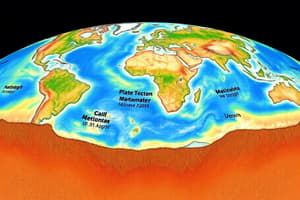Podcast
Questions and Answers
What are the limiting factors for species distributions?
What are the limiting factors for species distributions?
- Temperature
- Moisture
- Both A and B (correct)
- None of the above
Which of the following are potential responses of species to climate change? (Select all that apply)
Which of the following are potential responses of species to climate change? (Select all that apply)
- Adapt (correct)
- Evolve (correct)
- Seek new habitat (correct)
- None of the above
What is the definition of 'biosphere'?
What is the definition of 'biosphere'?
The sphere of life and organic activity, from the ocean floor to 8 km altitude into the atmosphere.
What are the components of biotic factors in an ecosystem?
What are the components of biotic factors in an ecosystem?
During photosynthesis, the equation is: Carbon Dioxide + Water + Solar Energy → ______ + Oxygen.
During photosynthesis, the equation is: Carbon Dioxide + Water + Solar Energy → ______ + Oxygen.
Nitrogen is combined into a usable form for plants by ______ bacteria.
Nitrogen is combined into a usable form for plants by ______ bacteria.
The food web is a simple linear representation of feeding relationships in an ecosystem.
The food web is a simple linear representation of feeding relationships in an ecosystem.
What is a detritivore?
What is a detritivore?
What are primary consumers primarily referred to as?
What are primary consumers primarily referred to as?
Match the following terms with their definitions:
Match the following terms with their definitions:
Flashcards are hidden until you start studying
Study Notes
Species Distributions and Climate Change
- Temperature and moisture affect species distribution
- Climate change impacts temperature and moisture levels
- Species respond to changing climate by adapting, evolving, migrating to new habitats, or going extinct
- Species movement may be northward or upward in elevation
Invasive Species in Ontario
- Invasive species are non-native organisms that negatively impact native ecosystems.
- Ontario has a diverse range of invasive species:
- Land animals and invertebrates: 5 species (e.g., nutria)
- Insects: 17 species
- Fish and aquatic invertebrates: 20 species
- Aquatic plants: 15 species
- Other plants: 17 species (e.g., kudzu)
- Pathogens: 8 species (e.g., Dutch elm disease)
Ecological Concepts
- Biosphere: encompasses all life on Earth, from ocean floor to the atmosphere
- Ecosystem: a self-sustaining community of living organisms interacting with their physical environment
- Ecology: the study of relationships between organisms and their environment
- Biogeography: the study of the distribution of plants and animals
Biotic Components of Ecosystems
- Producers (plants): self-feeders or autotrophs, convert sunlight into energy
- Consumers (animals): obtain energy by consuming other organisms
- Detritus feeders (worms, mites): consume decaying organic matter
- Decomposers (bacteria, fungi): break down organic matter, releasing nutrients
Energy Conversion and Biomass
- Plants convert sunlight into food through photosynthesis
- Approximately 270,000 plant species exist, with most being vascular
- Only 20 plant species account for 90% of the world's food supply
- Wheat, maize (corn), and rice are the top 3 food sources
Photosynthesis and Respiration
- Photosynthesis: converts light energy into chemical energy (sugars)
- Equation: Carbon dioxide + Water + Solar energy -> Carbohydrate (sugar) + Oxygen
- Respiration: breaks down sugars for energy
- Equation: Carbohydrate (sugar) + Oxygen -> Carbon dioxide + Water + Heat energy
- Net photosynthesis is the difference between the rate of photosynthesis and respiration
Elemental Cycles
- Hydrogen, oxygen, and carbon are the most abundant elements in living organisms
- These elements make up over 99% of Earth's biomass
- Biomass refers to the total weight of organic matter and its stored energy
- Nitrogen, calcium, potassium, magnesium, sulfur, and phosphorus are essential nutrients for organism growth
- Earth's biogeochemical cycles involve the recycling of gases (oxygen, carbon, nitrogen) and sedimentary nutrients
The Nitrogen Cycle
- Nitrogen is essential for plant growth but not directly usable from the atmosphere
- Nitrogen-fixing bacteria convert atmospheric nitrogen into usable forms (nitrates, ammonia)
- Plants absorb nitrates and ammonia to produce organic matter
- Consumers ingest nitrogen through their food
- Decomposers release nitrogen from organic waste, returning it to the atmosphere
The Gulf of Mexico Dead Zone
- Excess nitrogen from fertilizers enters waterways and ultimately the ocean
- This nitrogen overload stimulates algal blooms
- Algal decay depletes dissolved oxygen, creating a "dead zone" with limited marine life
Food Chains and Food Webs
- Producers are the foundation of food chains, manufacturing their own food
- Energy flows from producers to consumers (herbivores, carnivores), and ultimately to detrivores
- Food webs are interconnected food chains representing complex energy flow
- Organisms sharing similar food sources reside at the same trophic level
Simplified Terrestrial Food Chain
- Primary consumers (herbivores) feed on producers (plants)
- Secondary consumers (carnivores) feed on primary consumers
- Omnivores consume both producers and consumers
- Tertiary consumers (top carnivores) feed on primary and secondary consumers
Detritivores and Decomposers
- Detritivores play a crucial role in nutrient cycling, breaking down organic matter
- They include detritus feeders and decomposers
- Detritus refers to dead organic debris
- Detritus feeders consume detritus (e.g., worms, mites, termites)
- Decomposers (bacteria, fungi) break down organic matter outside their bodies, releasing nutrients
Ecosystem Components
- Ecosystems include biotic (living, e.g., plants, animals) and abiotic (nonliving, e.g., temperature, water) components
- Most ecosystems rely on solar energy, except those in dark caves or on the ocean floor, which use chemical reactions
- A community is formed by interactions among populations of living organisms in a specific area
Studying That Suits You
Use AI to generate personalized quizzes and flashcards to suit your learning preferences.




